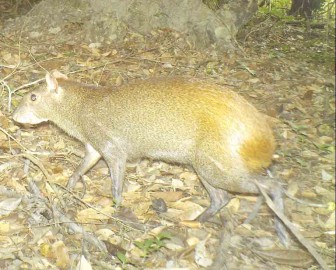The Red-rumped Agouti (Dasyprocta leporine) is locally known as the Akuri in Guyana. The species is native to South American especially the north Amazon countries. The agouti can be found in a wide range of habitats including swampy areas, tropical forest, savannahs, scrub forest and people’s gardens and farms.
The male and female have similar appearance but the female is larger. As a prey species this animal has a streamlined body designed for speed with powerfully built hindquarters to provide the speed needed when escaping from predators; all carnivores including wild cats, jaguar, harpy eagle and humans will prey on the agouti. The forelimbs are shorter than the hind legs and have four toes while the hind feet have three toes. The species can weigh as much as 6 kilograms. The fur is usually olive speckled brown with a patch of orange or red hairs on the rump.
The underside is usually orange brown with a strip of white running down the middle.
Agoutis are monogamous and often live in pairs or small family groups consisting of parents and offspring; they produce 1 – 3 young after a gestation period of 104 -120 days. Locally they are more often seen in pairs or solitary, and in Guyana, the species is believed to breed during the rainy season between June and July. The young can run within an hour of its birth and this greatly increases its chances of survival. In captivity the Agouti is known to live as long as 20 years, however life expectancy in the wild is unknown; it is believed that the male’s life expectancy is shorter than the female as they tend to live in more open areas.

Makushi Amerindians believe that if a pregnant woman tickles her ears daily with an Agouti whisker this will encourage her to sneeze and in turn lead to a speedy and easy birth.
Agoutis feed mainly on seeds and fruits and are important for dispersing seeds in the forest. During periods of shortage they will also feed on leaves, animal and plant parts. Agoutis are also known for burying their food in caches for hard times, and they play a major role in seed dispersal as they often forget where many of their caches are.
Some plant species such as the Brazil Nut tree, are dependent on the species to disperse their seeds, and can suffer if the agouti population declines. Agoutis can be a problem for people if their habitats are destroyed and they move into farms and gardens to feed. As a prey species they can also affect predator population, locally and across its range the Agouti is hunted and eaten.This species has no conservation status on the IUNC threatened species list.
Rain forests are rich in biodiversity and are home to many different plants and animals. In addition, indigenous communities make their homes there. Even if you don’t live in the rain forest, humans rely on the forest for resources such as building materials (wood and lianas), medicine and fruits. Rain forests also provide essential environmental services for life on earth; they create soil as well as prevent soil erosion, produce oxygen though photosynthesis, maintain clean water systems, and are a key defence against climate change.
The Iwokrama Rain Forest is 371,000 hectares, located in the heart of Guyana. Our mission is to develop strategies for conservation and sustainable development for local people in Guyana and the world at large. We are involved in tourism, training, research and our timber is certified by the Forest Stewardship Council. Come and visit us in the rain forest or at http://www.iwokrama.org.





